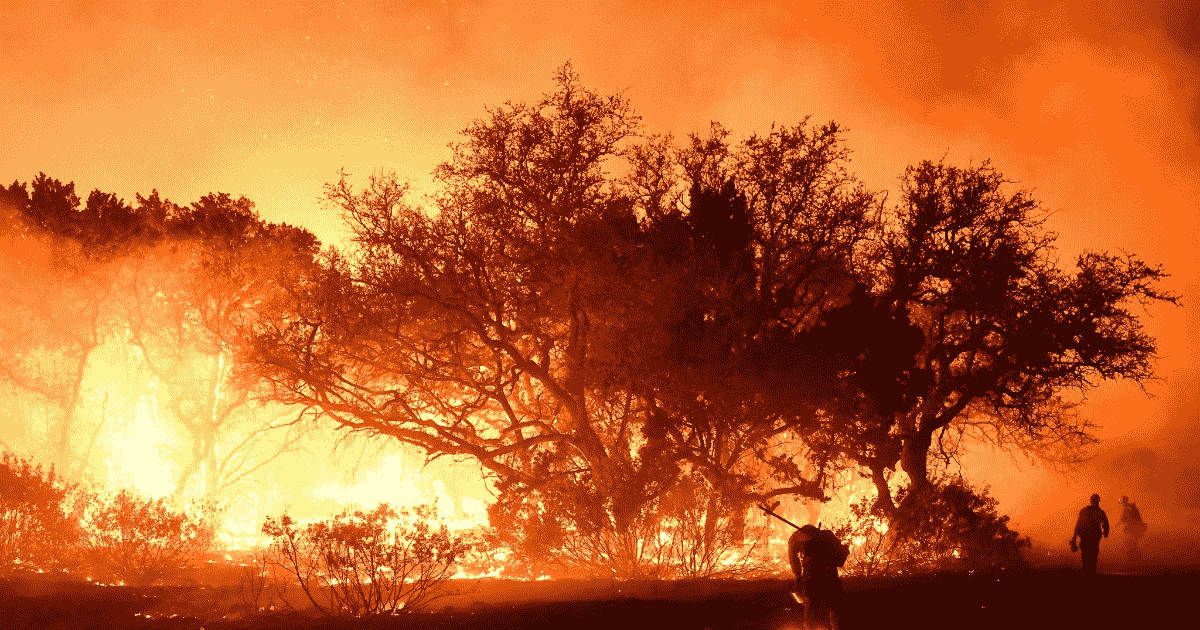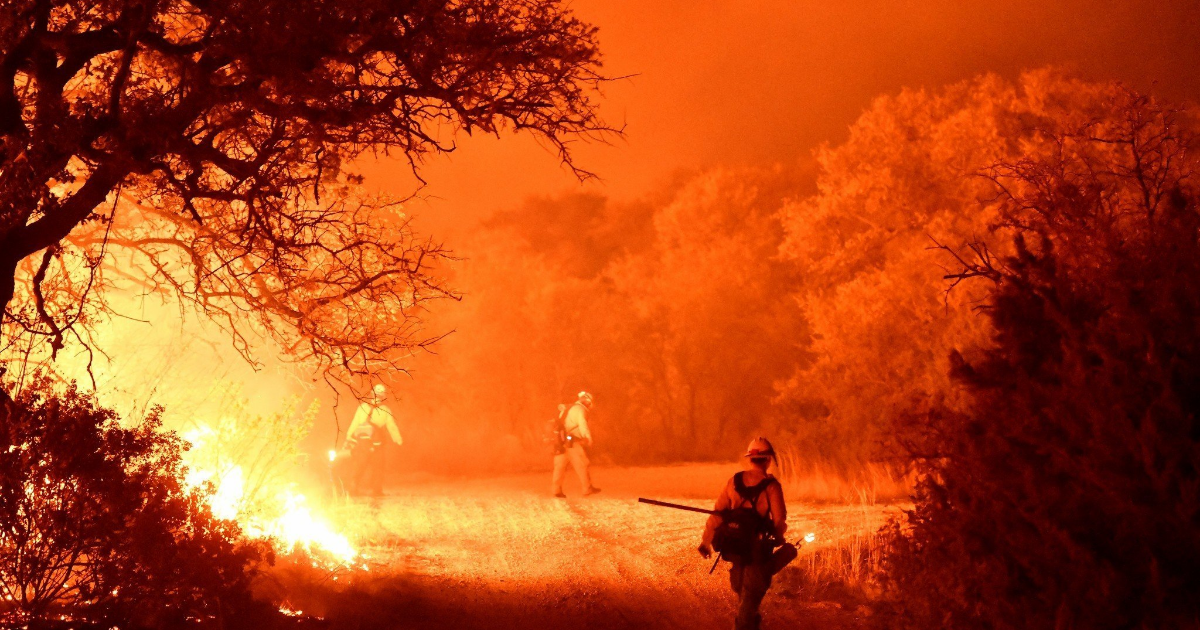
In a grim turn of events, Texas is grappling with a colossal wildfire that has rapidly expanded to a staggering 500,000 acres, marking it as the second-largest wildfire in the state’s history. The Smokehouse Creek fire ignited on Monday, has wreaked havoc, necessitating evacuations, causing power outages, and even leading to the partial evacuation of the Pantex Nuclear Weapons Plant.
Unprecedented Scale of Devastation By Texas wildfires
The Smokehouse Creek fire, fueled by strong winds and dry conditions, has defied containment efforts, spreading at an alarming rate. Erin O’Connor, spokesperson for the Texas A&M Forest Service, described it as a “significant fire” that has rapidly engulfed the landscape, becoming the second-largest wildfire in Texas, following the Amarillo Complex in 2006, which scorched around 1 million acres.
The fire, propelled by relentless gusts of strong winds and exacerbated by persistently dry conditions, has proven to be an immense challenge for containment efforts. Despite the concerted attempts by firefighting authorities, the fire has eluded control measures and, instead, exhibited an alarming rate of expansion. Erin O’Connor, the spokesperson for the Texas A&M Forest Service, has characterized the situation as nothing short of a “significant fire.”
The severity of the blaze is underscored by its rapid engulfment of the expansive Texas landscape. In a matter of days since its ignition, the fire has morphed into the second-largest wildfire in the recorded history of Texas. This unsettling distinction places it just behind the Amarillo Complex, which wreaked havoc in 2006 by scorching an immense expanse of approximately 1 million acres.
The confluence of strong winds and dry environmental conditions has created a volatile combination, providing the ideal fuel for the Smokehouse Creek fire’s ferocious advance. Erin O’Connor’s description of the fire as “significant” encapsulates not only its sheer size but also its ability to outpace containment efforts, posing an imminent threat to both the immediate and broader landscape.
As the fire continues its uncontrolled spread, the challenges faced by firefighting teams intensify. The magnitude of the Smokehouse Creek fire serves as a stark reminder of the unpredictable nature of wildfires, with their capacity to swiftly evolve into catastrophic events, driven by environmental conditions that exacerbate their destructive potential.
Immediate Response and Evacuations
The Pantex Plant is open for normal day shift operations for Wednesday, February 28; all personnel are to report for duty according to their assigned schedule.
— Pantex Plant (@PantexPlant) February 28, 2024
In light of the intensifying crisis posed by the Smokehouse Creek fire, Governor Greg Abbott has taken decisive action by declaring a state of disaster in 60 counties. This strategic move serves as a critical step to mobilize and deploy state resources efficiently, aiming to support local firefighters and enhance their capacity to combat the escalating wildfire.
The gravity of the situation is further underscored by the imposition of mandatory evacuations in several towns directly in the path of the advancing flames. Residents of Skellytown, Wheeler, Allison, and Briscoe have been directed to evacuate, recognizing the imminent danger posed by the rapidly spreading fire. In Amarillo, additional evacuation orders have been issued, reflecting the expansive reach and unpredictability of the Smokehouse Creek fire.
The severity of the crisis is vividly demonstrated by the evacuation of the Hemphill County Hospital District. In a move that highlights the urgency of the situation, all patients and staff were evacuated from the medical facility. This evacuation not only emphasizes the potential threat to human lives but also showcases the need for comprehensive measures to safeguard the health and well-being of the community in the face of this wildfire emergency.
Governor Abbott’s declaration of a disaster, coupled with the implementation of mandatory evacuations and the evacuation of critical medical facilities, reflects a coordinated and proactive approach to addressing the multifaceted challenges posed by the unfolding wildfire. As communities grapple with the immediate impacts and potential threats, the decisive actions taken by state authorities are pivotal in mitigating the risks and ensuring the safety of residents in the affected regions.
Impact on Infrastructure
The relentless wildfires have extended their impact beyond residential areas, affecting crucial infrastructure, with the Pantex Nuclear Weapons Plant facing the consequences. As a pivotal facility responsible for the intricate tasks of assembling and disassembling atomic bombs, the gravity of the situation prompted the plant to take precautionary measures.
In response to the imminent threat posed by the wildfires, the Pantex Nuclear Weapons Plant found it necessary to evacuate nonessential personnel. This strategic decision aims to ensure the safety of individuals and minimize potential risks in the face of the encroaching fire. Evacuating personnel not directly involved in essential operations becomes a precautionary step to safeguard lives and prioritize the well-being of the workforce.
Despite the necessity of the evacuation, reassuring news emerges from the plant. Reports indicate that, thankfully, all weapons and special materials within the Pantex Nuclear Weapons Plant have remained secure and unaffected by the evolving wildfire. This development provides a sense of relief amid the challenges posed by the wildfire, underscoring the effectiveness of safety protocols and measures in place to protect critical assets.
The incident highlights the vulnerability of vital infrastructure in the face of natural disasters and the importance of implementing precautionary measures to mitigate potential risks. The successful protection of weapons and special materials at the Pantex Nuclear Weapons Plant serves as a testament to the resilience of emergency response protocols and the dedication of personnel involved in safeguarding facilities crucial to national security. As the wildfires continue to pose threats, ongoing vigilance and adaptive strategies remain essential to ensure the continued safety of critical infrastructure in the affected regions.
Power Outages and Emergency Measures
The scale of the wildfires has resulted in power outages affecting thousands of homes and businesses. PowerOutage.us reported 10,301 customers in the dark, emphasizing the widespread impact on communities. Governor Abbott’s disaster declaration is aimed at ensuring the swift deployment of resources to the affected areas, acknowledging the devastating consequences of the wildfires.
Weather Conditions and Forecast
The unpredictable nature of the fires is exacerbated by changing weather conditions. While Tuesday saw erratic shifts in the fires due to a change in wind direction, a brief respite is anticipated on Wednesday and Thursday with lighter winds. However, a return of strong winds on Friday poses a renewed threat, necessitating cautious optimism among firefighters.
Environmental Impact Of Texas Wildfires
The Smokehouse Creek fire’s ferocity is attributed to the dry, dead grasses in a drainage area, creating a perfect environment for rapid growth. The dense clouds of smoke billowing across roads signal not only immediate danger but also potential long-term environmental consequences.
Statewide Response and Governor’s Warning
Governor Abbott’s disaster declaration for 60 counties underscores the severity of the situation. Urging residents to limit activities that could spark new fires, he emphasized the need for precautions to protect loved ones. The governor also warned of the potential for further growth in the coming days, as high temperatures and windy conditions persist.
Conclusive Report by Trenditweetz
The Texas wildfires have unleashed a catastrophic blaze, testing the resilience of communities, emergency responders, and critical infrastructure. As the state grapples with this unprecedented challenge, the cumulative efforts of local and state authorities, aided by favorable weather conditions, will play a crucial role in containing and eventually extinguishing the Smokehouse Creek fire. The situation remains fluid, and ongoing updates are essential to guide residents and responders through this perilous ordeal.
FAQs About the Texas Wildfires
Q: What caused the Smokehouse Creek fire in Texas?
A: The Smokehouse Creek fire in Texas was ignited on Monday, fueled by dry, dead grasses in a drainage area and exacerbated by strong winds and dry conditions.
Q: How large is the Smokehouse Creek fire currently?
A: As of Wednesday morning, the fire has spread rapidly to an alarming 500,000 acres, making it the second-largest wildfire in Texas history.
Q: What is the status of containment efforts for the Smokehouse Creek fire?
A: Unfortunately, the fire remains uncontrolled, posing a significant challenge to containment efforts by the Texas A&M Forest Service.
Q: How has the Texas government responded to the wildfires?
A: Governor Greg Abbott issued a disaster declaration for 60 counties, activating state resources to aid local firefighters and address the widespread impact of the wildfires.
Q: Are there mandatory evacuations in effect for affected areas?
A: Yes, several towns and communities, including Skellytown, Wheeler, Allison, and Briscoe, are under mandatory evacuation orders. Additional voluntary evacuations are in place for Pampa.
Q: Has critical infrastructure been affected by the wildfires?
A: Yes, the Pantex Nuclear Weapons Plant, located northeast of Amarillo, evacuated nonessential personnel as a precautionary measure. However, all weapons and special materials are reported to be safe and unaffected.
Q: How many power outages have been reported due to the wildfires?
A: PowerOutage.us has reported 10,301 customers without power, emphasizing the widespread impact on homes and businesses in the affected areas.
Q: What weather conditions are expected in the coming days?
A: While Wednesday and Thursday may see a brief respite with lighter winds, there is a forecasted return of strong winds on Friday, posing a renewed threat to containment efforts.
Q: How is the environmental impact of the wildfires being addressed?
A: The dense smoke clouds from the fire raise concerns about both immediate dangers and potential long-term environmental consequences. Ongoing firefighting efforts aim to mitigate these impacts.
Q: What precautions are residents urged to take by Governor Abbott?
A: Governor Abbott has urged residents to limit activities that could create sparks and take precautions to keep their loved ones safe, recognizing the potential for further growth in the coming days.
Read More >>https://trenditweetz.com/chicago-weather-hourly/





